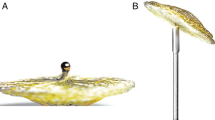Summary
In patients with a cryptogenic cerebral ischemia, the percutaneous closure of a patent foramen ovale (PFO) has gained increasing acceptance as an alternative strategy to prevent paradoxical embolism. Promising data with low recurrence rates have been reported for several self-expanding double disk devices. The implantation of the device is usually performed by passing the PFO. However, in one patient with a TIA (m, 43 years) transesophageal echocardiography (TEE) revealed an atrial septum abnormality with a hypermobile septum and a very small distance (≈12 mm) between the PFO channel and the anterior mitral valve leaflet, which was too short to accomodate the regular implantation procedure of the device via the PFO-channel itself. In this particular case the device (PFO-Star TSD) was advanced to the left atrium via an additional transseptal puncture – performed under TEE guidance – to allow for complete closure of the PFO without impairment of the mitral valve function. No periinterventional complications were observed. During the follow-up period of 9 months the patient was completely asymptomatic with no functional impairment of the mitral valve and no residual intracardiac shunt.
Zusammenfassung
Bei Patienten mit einem kryptogenen neurologischem Ereignis infolge einer paradoxen Embolie hat der perkutane Verschluss des offenen Foramen ovale (OFO) mit selbst-expandierenden Doppel-Schirm-Systemen zunehmend an Bedeutung gewonnen. Die Implantation dieser Verschlusssysteme erfolgt normalerweise via Sondierung des OFO. Bei einem der 99 von uns mit einem perkutanen PFO-Verschluss behandelten Patienten (m, 43 Jahre), welcher eine passagere Gesichtsfeldeinschränkung nach rechts erlitten hatte, zeigte sich in der transösophagealen Echokardiographie (TEE) neben einem hypermobilen Vorhofseptum ein sehr geringer Abstand zwischen OFO-Kanal und Ansatz des vorderen Mitralsegels (VMS), welcher bei dem verwendenden Schirmsystem (PFO-Star) nicht ausreichte, um bei regulärer Sondierung des OFO eine ausreichende Distanz zwischen der aufgespannten linksatrialen Schirmhälfte und dem VMS zu gewährleisten. Unter simultaner TEE-Kontrolle erfolgte die Implantation des Schirmsystems daher über eine zusätzliche transseptale Punktion. Hierdurch konnte das OFO erfolgreich verschlossen werden, ohne die Funktion des VMS zu beeinträchtigen. Periinterventionelle Komplikationen wurden nicht beobachtet. Während der 9-monatigen Nachbeobachtung war der Patient klinisch beschwerdefrei bei normaler Funktion beider Mitralklappensegel und ohne Residual-Shunt auf Vorhofebene.
Similar content being viewed by others
Author information
Authors and Affiliations
Additional information
Eingegangen: 30. Oktober 2001 Akzeptiert: 15. Februar 2002
Rights and permissions
About this article
Cite this article
Braun, M., Ehrhard, K., Strasser, R. et al. Katheterinterventioneller Verschluss eines ventiloffenen Foramen ovale über eine zusätzliche transseptale Punktion. Z Kardiol 91, 659–662 (2002). https://doi.org/10.1007/s00392-002-0820-4
Published:
Issue Date:
DOI: https://doi.org/10.1007/s00392-002-0820-4




